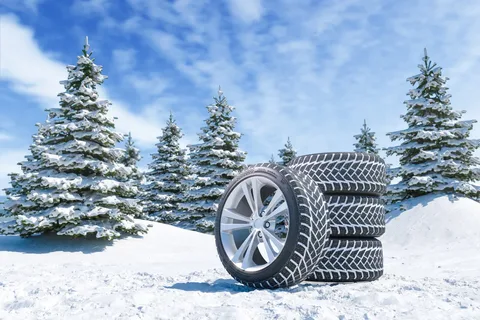Winter tires provide superior traction on snow and ice than any other type of tire. They also cause less damage to roadways than chains.
However, some people prefer the convenience of chains because they are easy to install and remove. In this article, we’ll explore the pros and cons of each option to help you decide which one is right for your vehicle.
Traction
Winter tires give you added traction for driving in snowy or icy conditions. This can help to prevent your car from sliding, which can lead to a loss of control and potentially an accident. They also offer a smoother ride than standard tires, so you and your passengers will be more comfortable.
In addition to offering enhanced traction, winter tires also protect your standard vehicle tires from damage that could be caused by snow or ice. The rubber in winter tires is softer than in all-season tires, so it is less likely to crack or lose shape after prolonged exposure to cold temperatures and moisture.
If you live in an area that receives a lot of snow, your regular tires will not have enough traction to deal with it. Even if your vehicle has all-wheel drive, it won’t have the power to overcome this lack of traction. That’s why it is important to invest in a set of winter tires before the first snowfall.
Another option for improving your traction is to use tire chains. These chains are loops of metal that you put over your tires for extra traction when necessary. These are available at many stores with auto sections and can be easily removed when the weather clears up. They can improve traction on ice and deep snow, but they don’t do as well on light coverings of snow.
Both chains and snow tires have their pros and cons, but it is important to think about what types of winter conditions you typically encounter in your area. For example, if you regularly drive on highways or other high-speed areas, tire chains may not be a good choice as they can affect your vehicle’s handling.
In general, snow tires provide better traction than chains because they have a specialized tread that is designed to dig into the ground and grip the road surface. They have narrower treads than all-season or summer tires so that they can fit more closely to the road, and their design includes a lug pattern with irregular edges that cut through snow and ice for enhanced traction.
Safety
During winter, driving conditions in some areas can become too dangerous for normal tires to handle. This is where snow tires and chains come into play to help drivers get from point A to point B while maintaining their safety. However, many drivers are unsure of whether or not snow tires are better than chains or vice versa. The answer is that it depends on the driver and the vehicle’s needs.
The main difference between snow tires and chains is traction. Snow tires offer better traction than regular tires in the snow and on ice, but they also have some disadvantages when driving on bare pavement. Ideally, snow tires should be used on a dedicated spare for these types of conditions so they can be easily removed when driving on normal pavement. Using snow tires on your main set of wheels is generally not recommended because it can reduce the lifespan of your normal tires.
Snow chains, on the other hand, can be much easier to use. They can be fitted to the same tires as your regular ones and are available at most automotive stores with car care sections. Regardless of which type of chains you choose, it is important to buy the right size for your vehicle. This will ensure that they fit properly and are not loose or too tight. It is also essential to read the instructions before applying them to your vehicle.
Another advantage of snow chains is that they are typically less expensive than snow tires. Depending on the type of chain you choose, they can cost anywhere from PS30 to PS70 for passenger vehicles. However, it is important to note that these costs can rise significantly for premium snow chains or those designed for large or limited clearance vehicles.
Although both snow chains and winter tires provide excellent traction, there is no clear winner when it comes to safety. Snow chains are better suited for icy roads and deep snow, while snow tires work best on lighter coverings of snow. However, both options should be considered if you live in an area that experiences frequent snowstorms.
Cost
Winter tires can be expensive if you are buying them for all four of your vehicles. They also need to be professionally installed and removed each year. However, they offer a number of advantages over chains. They perform better on ice and deep snow, are easier to remove and mount, and generally create less damage to roads than chains. They are the preferred choice for many drivers.
Chains are often less expensive than a set of snow tires, but they can cause severe and permanent damage to roadways if not used properly or left on too long. They are not recommended for use on dry pavement, and driving with them on can be a bone-rattling experience. They can also be difficult to remove and install on your vehicle and require a lot of space in your garage or driveway when not in use.
When considering whether to get snow tires or chains, it is important to consider the terrain in which you will be driving and the climate in which you live. If you live in a place where snowy weather is common, it may be worth the investment to have both. This way, you can have the best of both worlds, with the added traction of winter tires and the added security of chains when needed.
In addition, the studs in studded snow tires can be quite damaging to roadways and should only be used when absolutely necessary. This is why some states have laws limiting the use of studded snow tires, and they must be removed at the end of the season. Similarly, chains can be very damaging to roads and are not allowed in some areas at certain times of the year.
Ultimately, the decision between snow tires and chains comes down to cost and terrain. If you live in a place where winter is very common, snow tires are the smarter investment, as they will provide excellent traction all season long and make it much easier to navigate roadways glazed with snow. If you do not drive in a very snowy area, chains are a cheaper option and can help give you the traction you need in extreme conditions.
Maintenance
Winter tires are the best way to improve traction for cold-weather conditions. They have softer rubber and thicker tread patterns that dig deeper into snow and ice than regular all-season or summer tires. Plus, they can handle slush and ice as well, making them a great option for places with unpredictable winter weather. The downside is that they require special tools to install and remove them. Plus, they add to your vehicle’s overall weight and wear on the road. The decision to go with tires or chains is a personal one, and your choice should be based on factors like the terrain you drive on, how often you need traction aids, and your financial availability.
Tire chains are the traditional solution for snow and ice, but technological advancements are now giving drivers alternative options. You can opt for traction mats or chains that slip over the top of your tires. These traction devices are generally quieter and less expensive than metal chains. However, they don’t provide as much traction as snow tires or even studded tires. They are also better for light snow than heavy, deep snow.
The best way to determine which option is right for you is to consult your local automotive dealer or the owner’s manual for your specific car. Also, you may want to ask about state laws regarding the use of traction devices on certain roads. Depending on your location, you may find that it is illegal to drive without chains on certain roads during a winter storm.
While snow tires are the most efficient traction aid for winter, some people choose to add studs to their all-season or summer tires. This can be a good solution in some cases, especially if your area has heavy snowfall and is frequented by skiers and snowboarders. Just keep in mind that adding studs to your tires will cause them to wear down faster than normal. It is also important to practice putting on and taking off studs at home before you try them in the cold. This will ensure that you don’t damage your tires or get stuck while driving in the mountains or in a city.





